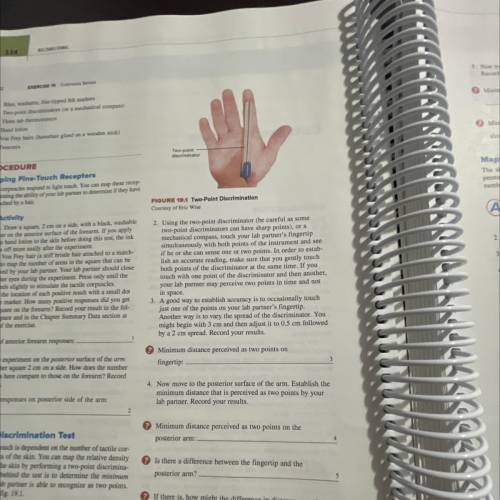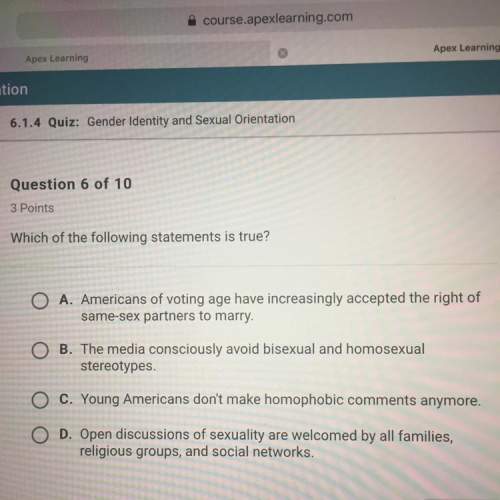FIGURE 19:1
Courtesy of Eric Wise
able
bly
ink
ch-
e
ase
...

Health, 03.04.2021 03:20 waldruphope3956
FIGURE 19:1
Courtesy of Eric Wise
able
bly
ink
ch-
e
ase
2. Using the two-point discriminator (be careful as some
two-point discriminators can have sharp points), or a
mechanical compass, touch your lab partner's fingertip
simultaneously with both points of the instrument and see
if he or she can sense one or two points. In order to estab-
lish an accurate reading, make sure that you gently touch
both points of the discriminator at the same time. If you
touch with one point of the discriminator and then another,
your lab partner may perceive two points in time and not
in space.
3. A good way to establish accuracy is to occasionally touch
just one of the points on your lab partner's fingertip.
Another way is to vary the spread of the discriminator. You
might begin with 3 cm and then adjust it to 0.5 cm followed
by a 2 cm spread. Record your results.
1
3
Minimum distance perceived as two points on
fingertip:
4. Now move to the posterior surface of the arm. Establish the
minimum distance that is perceived as two points by your
lab partner. Record your results.
4
Minimum distance perceived as two points on the
posterior arm:
Is there a difference between the fingertip and the
posterior arm?
5
If there is, how might the difference in distance perceived
be explained in terms of the number of nerve endings per
unit area?
6.


Answers: 1


Another question on Health

Health, 21.06.2019 20:30
Being quick to anger, distrusting others, and having a cynical attitude are toxic characteristics of which personality type?
Answers: 3

Health, 22.06.2019 23:40
Tanya is not able to solve a problem because she’s unable to see it from a fresh perspective. which obstacle to problem solving is tanya experiencing? a. fixation b. counterproductive heuristic c. confirmation bias d. overconfidence
Answers: 2

Health, 23.06.2019 05:00
The parents of a 9-year-old girl bring their daughter to the ed. for the last 12 hours, the child has suffered severe nausea and vomiting, as well as diarrhoea and abdominal cramps. further discussion with the child indicates that she suffers from blurred vision and headache. the parents originally were worried about bringing the child to the ed because they feared deportation since the family are illegal immigrants employed to pick strawberries on a nearby farm. on direct questionning, the parents admit that the child was assisting with spraying crops with pesticides the previous day. none of the family members was wearing any protecting clothing. her bp is 88/48 mmhg, pulse is 90/min, rr 33/min, temp 38 c. the child appears sweaty and confused. auscultation of the lungs reveals a diffuse wheeze bilaterally. pupils are miotic and the child has diffuse muscle weakness. which of the following interventions is the most appropriate treatment? - atropine- charcoal- glucagon- naloxone- exposure: consider organophosphate poisoning, which inhibits cholinesterase and results in accumulation of ach in both muscarinic and nicotinic sites. pralidoxime activates achatropine competes with ach only at muscarinic receptors, but will not reverse nicotinic effectscharcoal = gastric decontaminationglucagon = reverse beta-blocker overdosenaloxone = reverse effects of opioids
Answers: 3

Health, 23.06.2019 07:30
Recognizing your emotions is an important first step toward a. dealing with them in a healthy way b. acting on them immediately c. using defense mechanisms to deal with them d. denying that they exist
Answers: 2
You know the right answer?
Questions


Physics, 20.11.2020 07:50

Social Studies, 20.11.2020 07:50

Mathematics, 20.11.2020 07:50

World Languages, 20.11.2020 07:50

Mathematics, 20.11.2020 07:50



English, 20.11.2020 07:50


Chemistry, 20.11.2020 07:50

Mathematics, 20.11.2020 07:50

Physics, 20.11.2020 07:50



Arts, 20.11.2020 07:50

History, 20.11.2020 07:50



Mathematics, 20.11.2020 07:50




